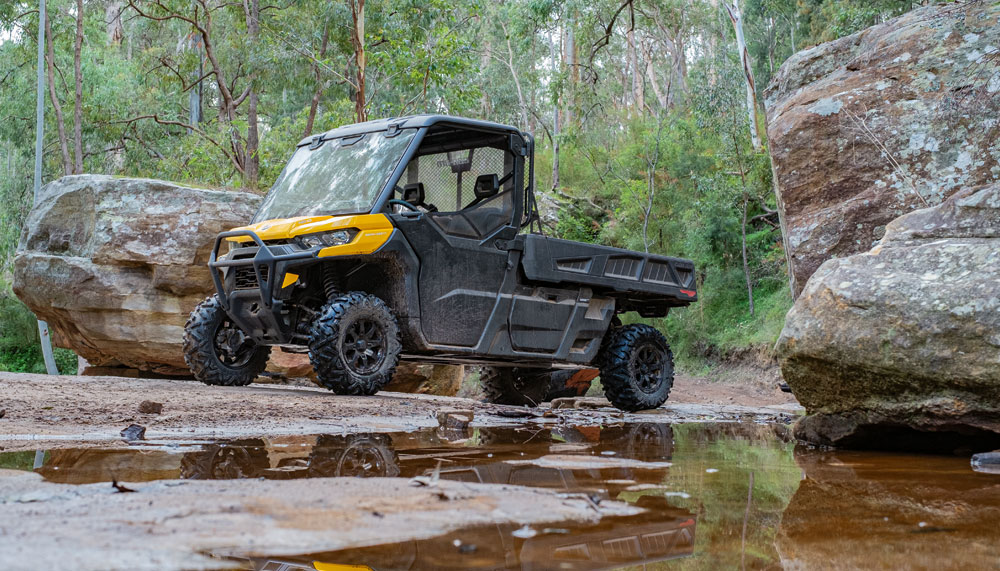The extremely capable Can-Am Defender now comes with a 1.8m long tip tray.
Story Ken Eastwood Photo Peter Pap
In a major shake-up of the farm all-terrain vehicle industry in Australia, most manufacturers are no longer importing ATVs as a result of the government’s new safety standards, which will come into effect from October. This means that, increasingly, farm consumers will turn to the growing side-by-side market for hardworking, go-anywhere vehicles.
In the larger side-by-sides, Can-Am has secured pole position for the past few years, cornering about a third of the market, especially since the Defender replaced the earlier Commander models four years ago. The latest incarnation of the Defender, the Pro XT HD10, includes a 1.8m x 1.4m tray, making it the largest on the market and almost the work equivalent of a much more expensive ute, but with even more capability up and down the toughest, rockiest terrain. It’s hard to find anything this brilliant machine can’t climb or descend.
When driving the Defender, the most surprising things are its quietness and comfort, as it bounces smoothly over potholes and tougher obstacles. Unlike in other side-by-sides, the engine has been moved out of the cockpit, and back under the tray. This keeps engine heat out of the cabin, makes it very easy to access and work on (once the tray is tipped) and also means that when you flip up the two passenger seats there is plenty of room in the cabin for extra cargo, such as a lambing ewe.
The hydraulic tray is easy to lift just by undoing a catch, but you can get an electronic assist as an extra if you’re likely to have regular heavy tipping loads.
Although initially designed in Canada, the Defender has been tried, tested and refined with feedback from Australian drivers, down to details such as a scalloped, cut-away seat that makes entry easier and reduces seat wear. It can easily do 100km/h on the road if you need to zip between paddocks, but comes with speed-limiter keys (both a 40km/h and 70km/h) for the ‘shorter’ family members, and won’t go above 20km/h unless the driver’s seatbelt is engaged. Combine this with the clutch-controlled engine braking (as soon as you take your foot off the accelerator, it starts backing off) and you end up with a pretty safe farm vehicle.
The 82hp Rotax engine has plenty of grunt, with an industry-leading 93 newton metres (69 foot-pounds) of torque, and the Defender’s towing capacity of 1134kg unbraked thrashes something like a Hilux’s 750kg. Although a towball is included, you may find the onboard storage enough, with a large, 316L under-tray cargo box out of the weather, and that huge tray taking a payload of up to 771kg. Even the tailgate has been made to be tough, holding up to 113kg. Remove a couple of bolts and the tray turns into a flatbed, or add the option of a cage for livestock or higher loads.
At 11m, the turning circle isn’t the best on the market, but the dynamic power steering is speed sensitive, making it easy to drive however fast or slow you’re going. The windscreen pops up for natural air-conditioning, or to allow shooters access straight out front. Ground clearance is only 33cm, but a solid central skid plate provides protection from protruding stumps or rocks.
Most side-by-sides on the market need to be serviced every 100 hours, but the Defender only requires servicing every 200 hours. It comes with a huge 41L fuel tank and two-year limited warranty.
If you’re more likely to be moving people than gear, the Defender HD10 also comes in a six-seater version, with a reduced tray size.
Not the cheapest side-by-side on the market, the Defender HD10 is deservedly being sold as a premium product. Robust, versatile, enjoyable to drive and capable of pretty much anything you throw at it, it’s difficult to fault.
This story excerpt is from Issue #138
Outback Magazine: August/September 2021









